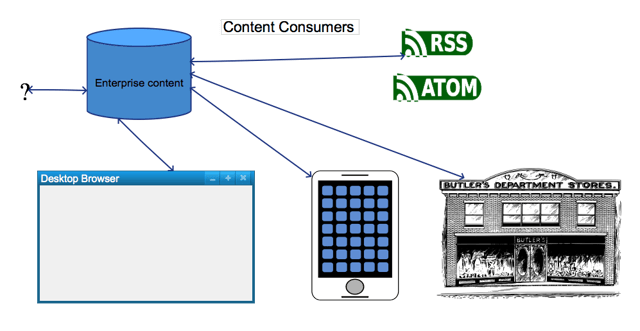Most modern e-Commerce platforms are omni-channel, and some of the challenges they encounter include:
- Having to deliver content across multiple platforms: e.g. mobile, desktop, and tablet;
- Internationalized content: in some cases, only certain parts of each page will vary by region;
- A critical need to personalize content, which is often key to conversion; and
- In some cases, partner sites may be embedding content that originates from the retailer.

What is CaaS?
Functionally, communication as a service is the ability to decouple content - both for creation and storage - from the delivery mechanism. Technically, it is the ability to serve up that content that insulates content consumers from the internal storage mechanics, through the use of API.
Let’s take a look at how CaaS can help some of the previously listed content challenges for us:
- It lends itself to omnichannel commerce and multichannel delivery of content
- Cloud friendly, since API end point locations are the only things that matter
- APIs are developer friendly, making for easier front-end development
- Personalization is easier, due to the ability to dynamically assemble pages with chunks of data
- Insights can be obtained on content consumption by internal and external users by monitoring API use
CaaS implements some of the following tenets:
Separating content from delivery channel:
Separation of concerns paradigm. For example, content that comprises a “page” when delivered on a mobile app may instead be rendered as a portion of one when delivered on a desktop application. Yet, in the repository the content is the same. Typically, content is stored as “chunks” instead of pages.
API-centric:
Content is exposed as resources, through REST API, in structured formats (typically as JSON or XML files).
Visualization for content creators:
Since the content can be repackaged for different channels and formats, it's important that content creators can easily preview the use cases. Obviously, this can be very challenging to implement.
Typically, these tenets are implemented by headless CMSes, that may also be de-coupled in their architecture. Some of the legacy CMS vendors also provide plugins that expose content as API's (see Joomla and others). Some CMS systems that have been built to implement these principles include DOTCMS, Contentful, and Cloud CMS.
Is CaaS right for your organization?
In theory this all sounds good. But as with any tool, there are several caveats that may make traditional integrated CMSes that serve up decorated content a better choice. CaaS may not be right for you if:
- You have a smaller organization that doesn’t do a lot of software development work
- Your presentation and customization needs can be easily accommodated by the CMS’s presentation capabilities
- The range of content consumers is very limited - perhaps to desktop and mobile content only
How does this affect your marketing and content editing organizations?
- Marketing gets more tools in its arsenal to more easily target content to specific groups
- Partners can consume content from your enterprise content media repo through standard API's
- Access to content can be throttled and charged for, through the use of API's and gateways
- Content editing can decrease significantly in complexity, since there is the opportunity to store pure content, with lesser presentation dependency
In short, there are probably more pros than cons to following this strategy, as long as your organization can afford it.





